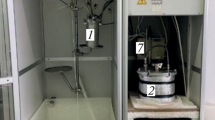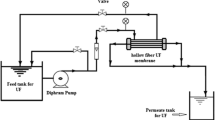Conclusions
-- The technical basis for the output of hollow fibres for ultrafiltration and separating apparatuses based on them which has been developed in the “Khimvolokno” NPO makes it possible to considerably expand the scale of these priority developments, which must be developed in our view in the following directions:
-
--on the basis of existing hollow fibre types of the VPU series, to develop narrowly specialized composite hollow fibres for various regions, for example, hollow fibres which have reduced sorption of proteins and improved washing ease for processes of concentrating protein solutions, bacteriocidal hollow fibres for processes of preparing food and nonpyrogenic water, and so forth;
-
--development of technology for the preparation of hollow fibres based on polysulfone for the filtration of strongly acid or strongly alkaline solutions, and also of hollow fibre membranes of cellulose for the filtration of organic solvents, fuel, clean-up of wastes containing oil, and so forth;
-
--development of hollow ultrafiltration fibres for medicinal purposes; these are primarily hollow fibres based on polysulfone or hydrocellulose for hemodialysis and polysulfone for hemofiltration.
Realization of the noted directions will make it possible approach significantly to the optimistic predictions which were examined above, and paths for realization have been indicated in the article named.
Similar content being viewed by others
Literature cited
É. M. Aizenshtein, G. A. Budnitskii, A. P. Borshchev, and Yu. A. Kostrov, 5th Int. Symposium on Man-Made Fibres, Kalinin (1990), Preprints, Vol. 4, p. 120.
L. P. Perepechkin and G. A. Budnitskii, Zh. VKhO im. D. I. Mendeleeva, 32, No. 6, 633 (1987).
G. A. Budnitskii, É. M. Aizenshtein, L. P. Perepechkin, and V. A. Bakunov, Summaries of reports at the scientific conference, “State and Development of Membrane Technology” [in Russian], TsINTIKhIMNEFTEMASh, Moscow (1989), p. 41.
G. A. Budnitskii, É. M. Aizenshtein, L. P. Perepechkin, V. A. Bakunov, and A. P. Borshchev, Summaries of reports of the scientific—technical conference, “Membrane Technology and Its Use in the National Economy” [in Russian], Chelyabinsk (1989), p. 51.
V. G. Andreev, É. M. Aizenshtein, S. A. Andreeva, and N. V. Pichugina, Contemporary Methods of Investigation of Hollow Fibres Used in Membrane Technology [in Russian], NIITÉKhIM, Moscow (1990).
E. A. Sapelkina, L. A. Fedorina, V. G. Andreev, and É. M. Aizenshtein, Summaries of reports of the First All-Union School Symposium, “Membrane Processes for Separating Liquid Mixtures” [in Russian], Riga (1989), p. 12.
É. M. Aizenshtein, G. A. Budnitskii, V. G. Andreev, and N. V. Pichugina, Int. Symposium on Membranes for Gas—or Vapor—Separation, Suzdal' (1989), Preprints, p. 57.
Membrane and Separation News, 6, No. 5, 2–3 (1988); No. 8, 12.
R. J. Peterson, World Water, 10, No. 8, 52–53 (1987).
W. Ehrfeld et al., J. Membrane Sci., 36, 67–77 (1988).
E. W. Becker et al., Microelectron. Eng., No. 4, 35–36 (1986); No. 5, 436–470.
A. Gollan, 5th Ann. Membrane Technol./Planning Conf., Cambridge, Mass., USA, October 21–23, 1987. Chem. Econ. Eng. Rev., 19, No. 205, 32–38 (1987).
Membrane and Separation Technol. News, 6, No. 4, pp. 2–3 (1987); Chem. Eng. News, 66, No. 6, 8 (1988).
Membrane and Separation Technol. News, 5, No. 8, 4 (1987); No. 9, 3–4.
N. I. Nikolaeva et al., Teoretich Osnovy Khim. Tekhnol., 14, No. 1, 29 (1980).
A. S. Tirak'yan et al., Khim. Volokna, No. 6, 26 (1988).
Yu. A. Kostrov et al., Khim. Volokna, No. 6, 49 (1986).
M. Frei, Flussiges Obst., 54, No. 9, 492–493, 496 (1987); P. Canera et al., Ind. delle bevande, 15, No. 89, 362–367 (1986).
Byull. Mezhdun. Vystavki ACHEMA-88, 5–11 (June 1988), Frankfurt-am-Mein, West Germany.
K. J. Kim et al., Proc. of the 1987 Int. Congress on Membrane and Membrane Processes, Tokyo, Japan, 6-12.06.87, 363–364.
F. F. Stengaard, J. Membrane Sci., 36, No. 257 (1988); Membrane and Separation Technol. News, 6, No. 7, 12.
Filtration and Separation, 25, No. 4, 25 (1988).
F. Vigo et al., J. Membrane Sci., 36, 187–199 (1988).
Additional information
Translated from Khimicheskie Volokna, No. 2, pp. 35–41, March–April, 1991.
Rights and permissions
About this article
Cite this article
Aizenshtein, É.M., Tirak'yan, A.S. & Borshchev, A.P. From hollow fibres to membrane plants. Fibre Chem 23, 100–109 (1992). https://doi.org/10.1007/PL00020058
Issue Date:
DOI: https://doi.org/10.1007/PL00020058




